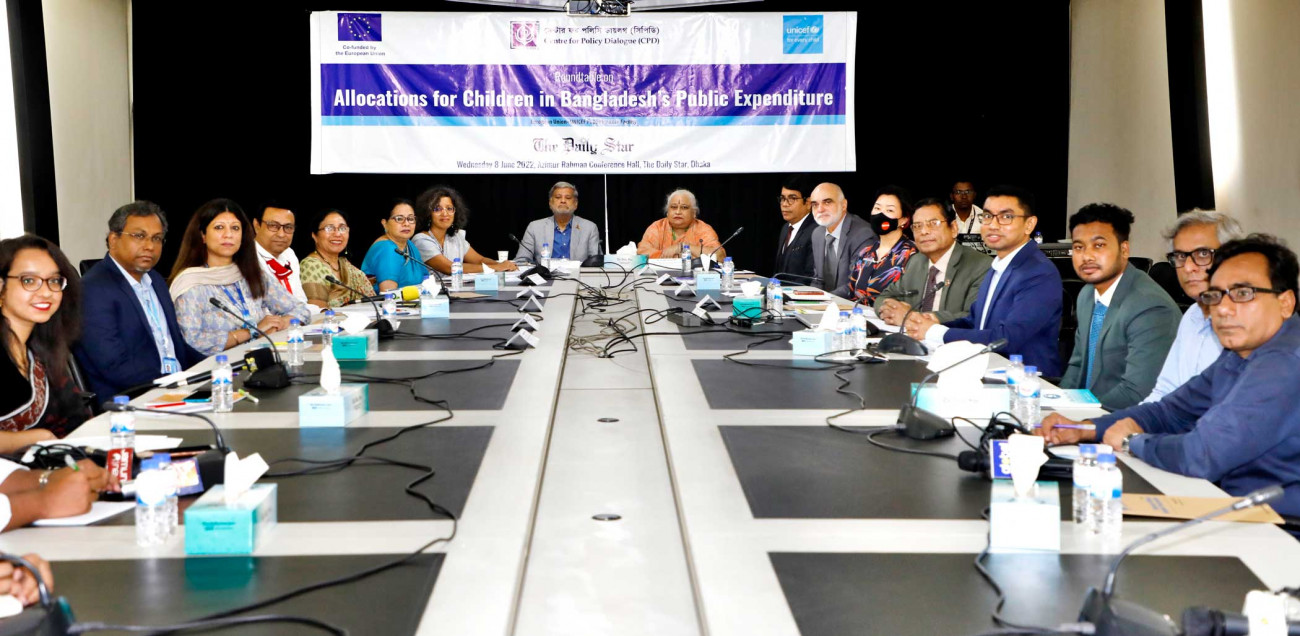Originally posted in The Daily Star on 27 July 2022

Professor Mustafizur Rahman, Distinguished Fellow, Centre for Policy Dialogue (CPD) (Keynote Presenter)
In FY2015-16, the government, for the first time, prepared a separate budget for children. This was a reflection of the government’s commitment towards raising the welfare of Bangladesh’s children.
Children, belonging to the 0-18 year age group, make up two-fifths of our population. Ensuring the well-being of children is a development issue and also a rights issue enshrined in our Constitution and embedded in various government policies.
Between 2013 and 2019, Bangladesh made commendable progress in several child indicators such as infant mortality rate and stunting. On the other hand, progress was stalled, and even reversed, in terms of several other indicators particularly because of Covid-induced shocks. A BIGD (2020) study revealed that about 59 percent of students had lower protein intake and 34 percent of the households were compelled to reduce food expenses for adolescents. These negative footprints will leave long-term implications for the subsequent growth of children if not addressed properly with targeted interventions. The key finding of these surveys is that children were disproportionately affected by the pandemic. If a certain group is disproportionately affected, you will have to give them disproportionate treatment in order to bring them to the same level as others. We need to keep this in mind when we discuss allocations for children.
Studies indicate that deprivations experienced by children at the early stage of development are difficult to adequately compensate for through interventions during subsequent stages. Any mitigating interventions at a later stage also prove to be highly costly. Consequently, investment in children is considered as an act of paying forward. It is important for Bangladesh to undertake and prioritise time-sensitive investments in today’s children while the country’s demographic window of opportunity is still open.
According to the Ministry of Finance estimates, allocation for children in FY2018-19 was found to be only about 14.1 percent of the national budget. The aspiration of raising this share to 20 percent by 2020 was mentioned in the budget speech of FY 2018-19. However, this was estimated to be only 15.3 percent in FY2019-20. Regrettably, child budget reports for the next two fiscal years (FY2020-21 and FY2021-22) have not been prepared.
CPD in partnership with UNICEF, as part of the EU-UNICEF Public Finance Facility for Children project supported by the European Union, undertook an exercise to estimate the child budget figures for FY2021-22. The objective was to highlight the need to increase the share of child budget in public expenditure, and enhance allocative efficiency by drawing attention to the specific needs of Covid-affected children.
The study found that while the budget of the selected 15 ministries/divisions in FY2021-22 has increased by 15.8 percent compared to the pre-Covid FY2019-20 budget, the share of child budget in total public expenditure had remained more or less the same. Over this period, the amount of the child budget rose to Tk 90,868 crore from the previous Tk. 80,197 crore, a growth of 13.3 percent. However, the share of the child budget in total public expenditure indeed saw a slight decline (from 15.3 percent to 15.1 percent); the same was the case in view of the GDP (from 2.78 percent to 2.63 percent).
If we look at the sectoral distribution, we see that 6 percent of the child budget has gone to the education sector, 12 percent to children’s health and 13 percent to various social safety net programmes. However, only about 1 percent has gone toward child protection. Since issues such as child labour, child marriage, learning losses and violence had acquired urgency during the pandemic, there is a need to allocate more resources in view of these emergent needs.
We also need to take note of not only monetary allocations but also issues such as timeliness and quality of implementation, effective management of the projects and overall good governance. To recall, average spending during the first 10 months of FY2021-22 by the 15 child budget concerned entities was only 49 percent. Thus, the share of implemented child budget was lower than that of allocation.
Based on the above study, we would like to put forward a number of suggestions. First, the child budget should be prepared and published on a regular basis. Second, efforts should be taken to meet the target of 20 percent of all public expenditures to be spent on children. Third, allocations in the child budget should be geared towards addressing current concerns and future needs of children. Fourth, targeted measures are needed to address Covid-induced challenges including compensating for learning losses, bringing dropped out children back to school, ensuring their access to essential health services, preventing child marriage and child labour and providing children with a safe environment to live and grow up in as productive adults. Fifth, social safety net programmes for children need to be expanded both horizontally and vertically with a special focus on early-year programmes (e.g., Universal Mother and Child Benefit Programme, for which we have already seen some improvements in the budget for FY2022-23). Sixth, child budget should be prepared considering the shifting demands of the children. Addressing Covid-induced adverse impacts should not only inform allocative priorities in the child budget of FY2022-23, but also the budgets to come in the next few years. Finally, implementation of child-centric measures in the budget should be reviewed on a regular basis with multi-stakeholder participation.

